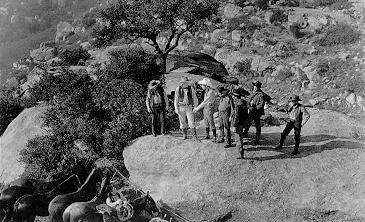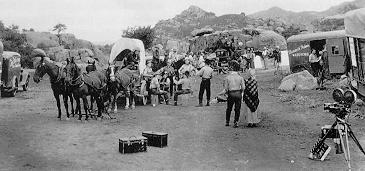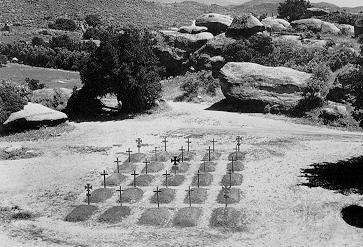|
IVERSON MOVIE RANCH

| The world famous Iverson Movie Ranch is the most photographed location ranch in motion picture history. Situtated in the Santa Susanna Mountains in the northwest corner of Chatsworth, California, it has been used to simulate the terrains of Asia, Africa, the South Seas, the old west, and any other locale the studios could wish for. |  

|

Take an indepth look at the ranch's use in films based on the writings
of
Edgar Rice
Burroughs including the Tarzan films

 Literally thousands of motion pictures and television shows have used the Iverson Movie Ranch for some or all of the scenes in the picture. This location ranch is probably the most recognizable site to movie viewers of all ages, whether it is the Garden of Gods site on the Lower Iverson (see picture to the right) or the chase roads on the Upper Iverson.
Literally thousands of motion pictures and television shows have used the Iverson Movie Ranch for some or all of the scenes in the picture. This location ranch is probably the most recognizable site to movie viewers of all ages, whether it is the Garden of Gods site on the Lower Iverson (see picture to the right) or the chase roads on the Upper Iverson.
The stars who have lensed here is a virtual who's who of Hollywood, including Shirley Temple in Wee Willie Winkie, Laurel & Hardy in The Flying Dueces, John Wayne in The Fighting Seabees, Gary Cooper in Lives of the Bengal Lancers, and Johnny Weissmuller, Buster
Crabbe, Lex Barker and Gordon Scott as Tarzan in various films.
In 1897 Charles J. Iverson homesteaded 160 acres of land in the Santa Susanna Mountains above Chatsworth, land on which Miss Augustus Wagman had been living on since 1880. In October 1888, she married Charles J. (Karl) Iverson, and from that union five children were born: Joe, Sena, Isaac, Anna, and Aaron.
In 1912 the California Aqueduct opened, bringing water (and people) to Los Angeles and the first film at Iverson was shot. The name of this first film has been reported as being The Squaw Man, but this is incorrect. Unfortunately, because of several fires, the ranch records have been lost.
The management of the ranch during the early years was handled by Karl, Augustus, and Joe. Around 1927, the ownership of the ranch was given to two of the sons, Joe and Aaron (the other children having moved away), but the profits were divided in thirds (the parents receiving one-third, Joe and Aaron receiving one-third each). By 1962, the ownership of the ranch was already divided into two sections: Joe owning the Lower Iverson, and Aaron owning the Upper Iverson [In the 1962 edition of the Studio Blu-Book Directory on page 36 is the following ad: "Aaron Iverson Ranch, Motion Picture & TV Location at the Upper (North) Section of Iverson Ranch, Consisting of Seven Location with Every Kind of Scenery including Miles of Scenic Roads and Insert Roads. There are many new improvements being made such as Western Street, Ranch Village, Lake, Pools, Bulldog Hills, Graves." Unfortunately, most of these improvements appear not to have been started.]
In 1966, the State of California began construction on the Simi Valley Freeway (118). This major thoroughfare cut the Iverson ranch in half, being built through the northern edge of the Lower Iverson. This freeway all but doomed the ranch as a viable movie location because of the high decibel sound levels caused by the traffic passing through the Santa Susanna Mountains.
In 1982, Joe Iverson sold the Lower Iverson to Robert G. Sherman, who almost immediately began subdividing most of the property. By 1998, Sherman had sold the ranch to a family which will keep the remaining acreage intact.
During the late 1980's, most of the ranch was subdivided into three portions: the Upper Iverson is now Indian Springs/Indian Falls, an exclusive gated community of 1 to 4 acre homesites, many of which have homes the size of mansions; the Lower Iverson is California West, a private residential condominium community; and the Middle Iverson is Summerset Village, consisting of luxury rental apartments.
 Even though paved roadways now sit on many of the Upper Iverson's chase roads and another roadway traverses the canyon between the Garden of the Gods and the Cliffs of Nyoka (see photo to the right), the major rock formations and terrains still remain intact.
Even though paved roadways now sit on many of the Upper Iverson's chase roads and another roadway traverses the canyon between the Garden of the Gods and the Cliffs of Nyoka (see photo to the right), the major rock formations and terrains still remain intact.
 In its days of glory, besides the magnificent rock outcroppings and general landscape, the ranch had a complete western street (see photo to the left), a three-sided ranch house with accompanying barn, and many small buildings that usually were used as outlaw shacks, stagecoach stops, and the like.
In its days of glory, besides the magnificent rock outcroppings and general landscape, the ranch had a complete western street (see photo to the left), a three-sided ranch house with accompanying barn, and many small buildings that usually were used as outlaw shacks, stagecoach stops, and the like.
| DIRECTIONS AND TOUR OF THE RANCH: To reach the Iverson Movie Ranch from Los Angeles, take the Golden State Freeway (5) north to the Simi Valley Freeway (118) west. The area surrounding the freeway from just before Topanga Canyon Boulevard to less than a mile farther west is the site of the ranch. The Lower Iverson is on the left and the Middle and Upper Iverson is to the right.
 Exit from the freeway at Topanga Canyon Boulevard and turn left (southward) passing beneath the freeway. The
mobile home park on the right side is where the western street once stood. Turn right at Santa Susanna Pass Road. At Redmesa Drive, turn right and head up the hill. Park just before you come to the first condominiums. To your right is the Lone Ranger Rock, the Cliffs of Nyoka (see below) and the stagecoach trail. To your left (west side), you will see a sign designating the area there as part of the Santa Monica Mountains Conservancy and a trail with a chain across it. Walk up that trail until you come to the Garden of the Gods. To reach the site of Vultura's palace (see Perils of Nyoka below), you will have to do some climbing/hiking as it lies east of the Cliffs of Nyoka (on private property). Except for the major rock formations, most of the Lower Iverson is covered with condominiums. Exit from the freeway at Topanga Canyon Boulevard and turn left (southward) passing beneath the freeway. The
mobile home park on the right side is where the western street once stood. Turn right at Santa Susanna Pass Road. At Redmesa Drive, turn right and head up the hill. Park just before you come to the first condominiums. To your right is the Lone Ranger Rock, the Cliffs of Nyoka (see below) and the stagecoach trail. To your left (west side), you will see a sign designating the area there as part of the Santa Monica Mountains Conservancy and a trail with a chain across it. Walk up that trail until you come to the Garden of the Gods. To reach the site of Vultura's palace (see Perils of Nyoka below), you will have to do some climbing/hiking as it lies east of the Cliffs of Nyoka (on private property). Except for the major rock formations, most of the Lower Iverson is covered with condominiums.
The Upper Iverson and adjoining Brandeis Ranch are no longer open to the public,
in a general sense, as it is now a gated community (closed sometime in late 1993 or early 1994).
There is access via a walkway to the northern hills and you are supposed to stay
on that path (thanks to Craig Baker for the correction). To reach Iverson Road, drive back down to Santa Susanna Pass Road, turn right (west) and travel a short distance (the Church of Rocky Peak will be at the corner) and turn right onto Iverson Road.
The Middle Iverson is partially open to the public, but apartments cover the main filming area, so there is no longer anything to see there. To reach it, travel north on Topanga Canyon Boulevard and turn left at Poema Place (the last road). This circles up into the Middle Iverson. A gate stops you from continuing into the Upper Iverson.
 The Upper Iverson was used mainly for stagecoach and horse chase scenes, for war scenes such as in The Fighting Seabees with John Wayne, and similar wideopen shots. Prior to the 1950's, there was only one major setting up there that I am sure of, an artificial cave opening next to an outlaw shack (this shack was used in the Lone Ranger t.v. series as the entrance to the hidden silver mine of the Ranger). As of 1993, all that remained of this set was the stone foundation. The Upper Iverson was used mainly for stagecoach and horse chase scenes, for war scenes such as in The Fighting Seabees with John Wayne, and similar wideopen shots. Prior to the 1950's, there was only one major setting up there that I am sure of, an artificial cave opening next to an outlaw shack (this shack was used in the Lone Ranger t.v. series as the entrance to the hidden silver mine of the Ranger). As of 1993, all that remained of this set was the stone foundation.
The Middle Iverson at one time had what is referred to as the three-sided house. The west, south, and east sides of the building could be filmed from different angles and made to appear to be different houses. A barn and outbuilding also were at this site.
 On the Lower Iverson, all through the different rock formations on this part of the ranch was where the majority of the standing sets were, whether it was a native Indian village, an outlaw hideout, a stagecoach stop, false cave mouth, or whatever the movie company wished for. Because of the rock formations, this is the most easily recognized area of the ranch. On the Lower Iverson, all through the different rock formations on this part of the ranch was where the majority of the standing sets were, whether it was a native Indian village, an outlaw hideout, a stagecoach stop, false cave mouth, or whatever the movie company wished for. Because of the rock formations, this is the most easily recognized area of the ranch.
|


The photograph of the Iverson Western Street and the Johnny Mack Brown's are used by permission of Stephen Lodge who photographed them during a Johnny Mack Brown film shoot.
 


|








 Literally thousands of motion pictures and television shows have used the Iverson Movie Ranch for some or all of the scenes in the picture. This location ranch is probably the most recognizable site to movie viewers of all ages, whether it is the Garden of Gods site on the Lower Iverson (see picture to the right) or the chase roads on the Upper Iverson.
Literally thousands of motion pictures and television shows have used the Iverson Movie Ranch for some or all of the scenes in the picture. This location ranch is probably the most recognizable site to movie viewers of all ages, whether it is the Garden of Gods site on the Lower Iverson (see picture to the right) or the chase roads on the Upper Iverson.
 Even though paved roadways now sit on many of the Upper Iverson's chase roads and another roadway traverses the canyon between the Garden of the Gods and the Cliffs of Nyoka (see photo to the right), the major rock formations and terrains still remain intact.
Even though paved roadways now sit on many of the Upper Iverson's chase roads and another roadway traverses the canyon between the Garden of the Gods and the Cliffs of Nyoka (see photo to the right), the major rock formations and terrains still remain intact.
 In its days of glory, besides the magnificent rock outcroppings and general landscape, the ranch had a complete western street (see photo to the left), a three-sided ranch house with accompanying barn, and many small buildings that usually were used as outlaw shacks, stagecoach stops, and the like.
In its days of glory, besides the magnificent rock outcroppings and general landscape, the ranch had a complete western street (see photo to the left), a three-sided ranch house with accompanying barn, and many small buildings that usually were used as outlaw shacks, stagecoach stops, and the like.
 Exit from the freeway at Topanga Canyon Boulevard and turn left (southward) passing beneath the freeway. The
mobile home park on the right side is where the western street once stood. Turn right at Santa Susanna Pass Road. At Redmesa Drive, turn right and head up the hill. Park just before you come to the first condominiums. To your right is the Lone Ranger Rock, the Cliffs of Nyoka (see below) and the stagecoach trail. To your left (west side), you will see a sign designating the area there as part of the Santa Monica Mountains Conservancy and a trail with a chain across it. Walk up that trail until you come to the Garden of the Gods. To reach the site of Vultura's palace (see Perils of Nyoka below), you will have to do some climbing/hiking as it lies east of the Cliffs of Nyoka (on private property). Except for the major rock formations, most of the Lower Iverson is covered with condominiums.
Exit from the freeway at Topanga Canyon Boulevard and turn left (southward) passing beneath the freeway. The
mobile home park on the right side is where the western street once stood. Turn right at Santa Susanna Pass Road. At Redmesa Drive, turn right and head up the hill. Park just before you come to the first condominiums. To your right is the Lone Ranger Rock, the Cliffs of Nyoka (see below) and the stagecoach trail. To your left (west side), you will see a sign designating the area there as part of the Santa Monica Mountains Conservancy and a trail with a chain across it. Walk up that trail until you come to the Garden of the Gods. To reach the site of Vultura's palace (see Perils of Nyoka below), you will have to do some climbing/hiking as it lies east of the Cliffs of Nyoka (on private property). Except for the major rock formations, most of the Lower Iverson is covered with condominiums.
 The Upper Iverson was used mainly for stagecoach and horse chase scenes, for war scenes such as in The Fighting Seabees with John Wayne, and similar wideopen shots. Prior to the 1950's, there was only one major setting up there that I am sure of, an artificial cave opening next to an outlaw shack (this shack was used in the Lone Ranger t.v. series as the entrance to the hidden silver mine of the Ranger). As of 1993, all that remained of this set was the stone foundation.
The Upper Iverson was used mainly for stagecoach and horse chase scenes, for war scenes such as in The Fighting Seabees with John Wayne, and similar wideopen shots. Prior to the 1950's, there was only one major setting up there that I am sure of, an artificial cave opening next to an outlaw shack (this shack was used in the Lone Ranger t.v. series as the entrance to the hidden silver mine of the Ranger). As of 1993, all that remained of this set was the stone foundation. On the Lower Iverson, all through the different rock formations on this part of the ranch was where the majority of the standing sets were, whether it was a native Indian village, an outlaw hideout, a stagecoach stop, false cave mouth, or whatever the movie company wished for. Because of the rock formations, this is the most easily recognized area of the ranch.
On the Lower Iverson, all through the different rock formations on this part of the ranch was where the majority of the standing sets were, whether it was a native Indian village, an outlaw hideout, a stagecoach stop, false cave mouth, or whatever the movie company wished for. Because of the rock formations, this is the most easily recognized area of the ranch.